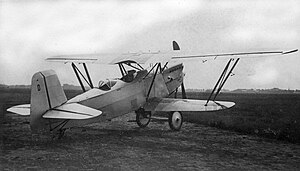The Albatros L 76 Aeolus was a German military reconnaissance aircraft built by Albatros Flugzeugwerke in 1927. The plane had wooden dual-spar wings with plywood skins supported by N-type struts and a fabric-covered fuselage made of welded steel tubing. The aircraft was used for testing,[1] as well as the training of the Soviet Air Force.[2] It was difficult to fly, and killed many people, including Emil Thuy,[3] who crashed near Smolensk on June 11, 1930,[1] and Paul Jeschonnek, who crashed near Berlin on June 13, 1929. As a result, it had to be improved, leading to the production of the Albatros L 77v, designed by Ernst Heinkel Flugzeugwerke.
| Albatros L 76 | |
|---|---|

| |
| Role | Reconnaissance aircraft |
| National origin | Germany |
| Manufacturer | Albatros |
| First flight | 1927 |
| Number built | 6 |
Operators
edit- Soviet Air Force - Two aircraft, used for tests and trials.
Specifications
editGeneral characteristics
- Crew: 2
- Length: 8.55 m (28 ft 1 in)
- Wingspan: 12.76 m (41 ft 10 in)
- Height: 3.74 m (12 ft 3 in)
- Wing area: 27.8 m2 (299 sq ft)
- Empty weight: 1,615 kg (3,560 lb)
- Powerplant: 1 × BMW VI inline engine, 450 kW (600 hp)
Performance
- Maximum speed: 235 km/h (146 mph, 127 kn)
Notes
edit- ^ a b Beauvais, Heinrich (2002). German secret flight test centres to 1945: Johannisthal, Lipetsk, Rechlin, Travemünde, Tarnewitz, Peenemünde-West. Midland. ISBN 978-1-85780-127-9.
- ^ Boyd, Alexander (1977). The Soviet Air Force since 1918. Stein and Day. p. 24. ISBN 978-0-8128-2242-7.
- ^ Musciano, Walter A. (1966). Eagles of the black cross. L. Obolensky. p. 261.
References
edit- Michael J. H. Taylor, Jane's Encyclopedia of Aviation. Studio Editions, London (1989).
- W.Green & G Swanborough, The Complete Book of Fighters. Salamander Books, London (1994). ISBN 1-85833-777-1